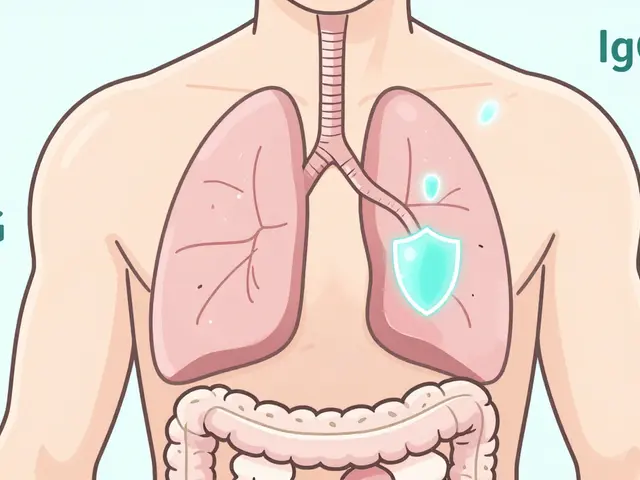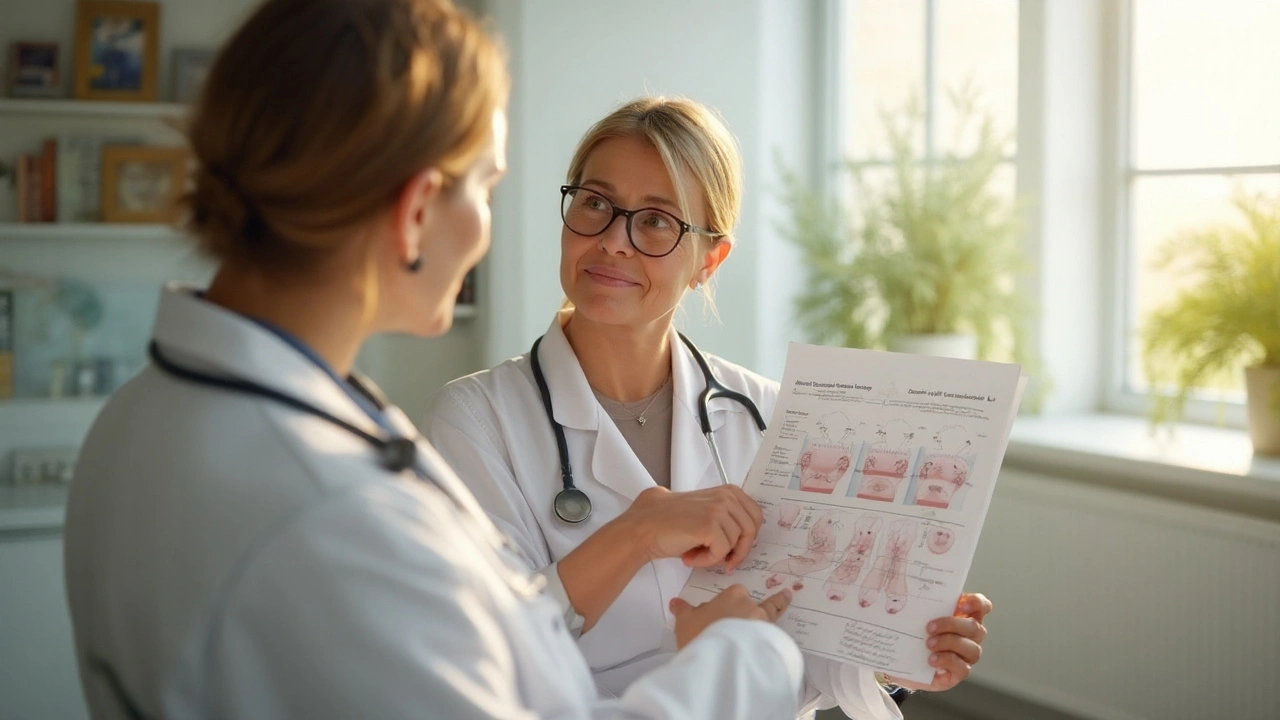When an itchy, blister‑filled rash appears on elbows, knees or the buttocks, many people think it’s just another bout of eczema. For a subset of patients, however, the culprit is dermatitis herpetiformis, a skin manifestation that signals deeper gluten‑related issues. This guide walks you through the science, the diagnosis, and, most importantly, everyday tactics to keep flare‑ups at bay.
What is Dermatitis Herpetiformis?
Dermatitis Herpetiformis is a chronic, intensely itchy skin disorder linked to gluten sensitivity and celiac disease, marked by clusters of small blisters and a burning sensation. It most often shows up on the elbows, knees, back, and scalp. Though the rash itself is visible, the underlying problem lives in the gut.
How It Connects to Celiac Disease
Celiac disease is an autoimmune condition where ingested gluten triggers an immune attack on the small‑intestinal lining. About 10‑20% of people with celiac disease develop dermatitis herpetiformis, and the skin lesions often appear before gastrointestinal symptoms. Understanding this link is key: treating the gut often calms the skin.
The Role of Gluten and IgA Antibodies
Gluten is a protein composite found in wheat, barley, and rye that can provoke an immune response in genetically susceptible individuals. In dermatitis herpetiformis, the immune system produces IgA antibodies that deposit in the skin’s papillary dermis, leading to the characteristic rash.
Spotting the Symptoms - From Pruritus to Blisters
Pruritus (itching) is the earliest and most troublesome symptom, often described as a burning or tingling sensation. Within days, small, raised bumps (papules) turn into vesicles that may burst, leaving a crusty, flaky surface. The itching worsens at night, disrupting sleep and quality of life.
Confirming the Diagnosis
A definitive diagnosis combines clinical observation with two key tests:
- Skin biopsy - a tiny piece of affected skin examined under a microscope for IgA deposits.
- Serology - blood work for elevated IgA anti‑tissue transglutaminase (tTG) or anti‑endomysial antibodies.
Because the rash can mimic other dermatoses, a biopsy is often the decisive step.
First‑Line Treatment: Dapsone
Dapsone is an antibacterial medication that rapidly reduces inflammation and itching in dermatitis herpetiformis, usually within 48-72hours. Typical dosing starts at 50mg daily, adjusted based on response and blood‑test monitoring for hemolysis and methemoglobinemia. While highly effective, long‑term use requires regular CBC checks.
Gluten‑Free Diet - The Long‑Term Strategy
Gluten‑free diet is the cornerstone of disease control, aiming to eliminate the trigger that fuels IgA production. Studies show that strict adherence can lead to a gradual reduction in rash severity and may eventually allow dose‑reduction or cessation of dapsone.
Key practical tips:
- Read labels for hidden wheat, barley, and rye derivatives (e.g., malt, hydrolyzed vegetable protein).
- Choose certified gluten‑free grains like rice, quinoa, buckwheat, and corn.
- Keep a food diary for at least four weeks to spot inadvertent sources.

Adjunctive Lifestyle Measures
Beyond medication and diet, several daily habits can blunt flare‑ups:
- Cool showers - hot water aggravates itching; opt for lukewarm water and pat skin dry.
- Loose clothing - breathable fabrics reduce friction and heat buildup.
- Topical corticosteroids - low‑potency creams can calm localized itching while dapsone takes effect.
- Stress management - cortisol spikes may intensify immune activity; try mindfulness or short walks.
Nutrition and Supplement Support
People with celiac‑related dermatitis often have nutrient malabsorption. Monitoring and supplementing the following can improve skin health:
- Iron - anemia can worsen fatigue and skin pallor; aim for 18mg/day (women) or 8mg/day (men).
- Vitamin B12 - 2.4µg/day; deficiency may contribute to neuropathic itch.
- Probiotics - strains such asLactobacillusGG may help restore gut barrier function, though evidence is still emerging.
Monitoring Progress and Knowing When to Seek Help
Regular follow‑up is essential:
- Blood tests every 3months while on dapsone (CBC, liver enzymes).
- Dermatology review if the rash spreads despite strict diet.
- Gastroenterology input for persistent intestinal symptoms or serology that remains elevated.
If you notice sudden worsening, fever, or blistering that rapidly turns purulent, treat it as a possible infection and contact a clinician immediately.
Comparison of Core Management Options
| Treatment | Typical Onset of Relief | Common Side Effects | Monitoring Needed |
|---|---|---|---|
| Dapsone | 24-72hours | Hemolysis, methemoglobinemia, rash | Complete blood count every 2-3months |
| Gluten‑free diet | Weeks to months | Nutrient deficiencies if not balanced | Serology (tTG) every 6-12months |
| Topical corticosteroids | Hours to days | Skin thinning with prolonged use | Skin inspection for atrophy |
Related Conditions and When They Overlap
Dermatitis herpetiformis shares features with other autoimmune skin diseases:
- Psoriasis - scaly plaques, but usually not triggered by gluten.
- Linear IgA disease - also IgA‑mediated blistering, but differs in histology.
- Atopic dermatitis - chronic itch, but lacks the characteristic IgA deposits.
Understanding these distinctions helps avoid misdiagnosis and ensures you receive the right therapy.
Next Steps for Readers
If you suspect dermatitis herpetiformis, start with a consultation that includes both a dermatologist and a gastroenterologist. Request a skin biopsy and serology panel, and ask about a referral to a dietitian experienced in gluten‑free planning. Remember, the sooner you combine medication with a strict gluten‑free diet, the faster you’ll see relief.
Frequently Asked Questions
Can I still eat oats on a gluten‑free diet?
Pure, uncontaminated oats are generally safe for most people with celiac disease, but cross‑contamination is common. Choose oats labeled ‘gluten‑free’ and monitor symptoms for a few weeks after introduction.
How long does it take for dapsone to work?
Most patients notice a reduction in itching within 24‑72hours. Full clearance of lesions may require a week or two of consistent dosing.
Is dermatitis herpetiformis curable?
There’s no permanent cure, but strict lifelong adherence to a gluten‑free diet often leads to long‑term remission, and many people can eventually taper off dapsone.
What skin‑care products should I avoid?
Stay away from harsh soaps, fragranced lotions, and alcohol‑based toners. Opt for hypoallergenic, fragrance‑free moisturisers and gentle, non‑soap cleansers.
Can stress make my rash worse?
Yes. Stress can amplify immune activity, leading to more IgA deposition and itching. Regular relaxation techniques can help keep flare‑ups under control.




Comments
17 Comments
sweta siddu
Great rundown-adding a probiotic like Lactobacillus GG can really help balance the gut! 😊
Steven Waller
The guide you’ve shared is a solid foundation for anyone confronting dermatitis herpetiformis.
Understanding that the skin manifestations are a mirror of intestinal immunity is essential for effective management.
While dapsone provides rapid symptomatic relief, it should be viewed as a bridge rather than a permanent solution.
Long‑term remission hinges on strict adherence to a gluten‑free diet, which gradually reduces IgA deposits in the skin.
Patients often underestimate hidden sources of gluten, such as maltodextrin or hydrolyzed vegetable protein, which can silently reignite the disease.
A systematic approach to label reading, perhaps using a checklist, can empower individuals to avoid these pitfalls.
Complementary strategies like cool showers and breathable clothing help to soothe the itch while the gut heals.
Topical corticosteroids remain useful for localized flare‑ups, but their use should be limited to prevent skin thinning.
Regular monitoring of blood counts while on dapsone is non‑negotiable, as hemolysis can be insidious.
Moreover, quarterly serology can indicate whether dietary compliance is translating into reduced antibody titers.
Nutritional deficiencies, especially iron and B12, deserve attention because they can exacerbate fatigue and neuropathic sensations.
Incorporating a certified dietitian into the care team ensures a balanced intake of essential micronutrients.
Stress management, though often overlooked, plays a measurable role; cortisol can amplify immune activity.
Simple practices such as mindfulness meditation or a brief daily walk have been shown to lessen perceived itch intensity.
Finally, fostering a supportive community, whether online or in‑person, can alleviate the psychological burden that accompanies chronic skin disease.
Puspendra Dubey
Yo, this whole DH saga feels like a tragiic drama-your skin's screaming for a gluten‑free encore, but the world keeps tossing you wheat‑laden traps! 😅
Nicola Gilmour
Remember, every small victory-like a week without a new blister-adds up to big progress.
Darci Gonzalez
Love the practical tips i’ll start a food diary tomorrow 🙌 it’ll help spot hidden gluten for sure
Marcus Edström
In many cultures rice and lentils form the staple, making a gluten‑free transition smoother for patients worldwide.
kevin muhekyi
Totally, and those simple swaps also keep meals affordable and tasty.
Teknolgy .com
Lol this article sounds like a textbook – boring but at least it covered the basics 😂
Caroline Johnson
Honestly, the author missed the point!!! No emphasis on *real* lifestyle changes!!!
Kelly Larivee
Thanks for sharing, I’ll try the cool shower tip tonight.
Emma Rauschkolb
The chronic pruritic cascade you described evokes a neuro‑immune feedback loop that’s just exhausting 😩.
Mara Mara
Great work; this information is vital for our community; keep spreading the word!
Jennifer Ferrara
The elucidation of the IgA‑mediated pathogenesis is commendable; however, I would suggets a deeper exploration of the microbiota‑gut–skin axis.
Terry Moreland
I totally get how frustrating the itch can be; you’re not alone in this journey.
Abdul Adeeb
It is imperative to note that ‘dapsone’ should be capitalised when initiating a sentence, and percentages must be expressed with a preceding zero, i.e., 0.1%.
Abigail Brown
Seeing the light at the end of the gluten‑free tunnel is possible! Each mindful meal you prepare is a triumph over the hidden adversary. Remember, setbacks are merely plot twists in your health saga, not the finale. Celebrate the days when the rash stays dormant, and let those victories fuel your resolve. The community stands beside you, cheering every step. Keep the momentum, and the skin will eventually echo your inner peace. Together we rewrite the narrative of dermatitis herpetiformis!
Crystal Slininger
What the pharmaceutical industry doesn’t tell you is that dapsone’s side‑effects are downplayed to keep profits high; a truly gluten‑free lifestyle is the only sustainable cure.
Write a comment